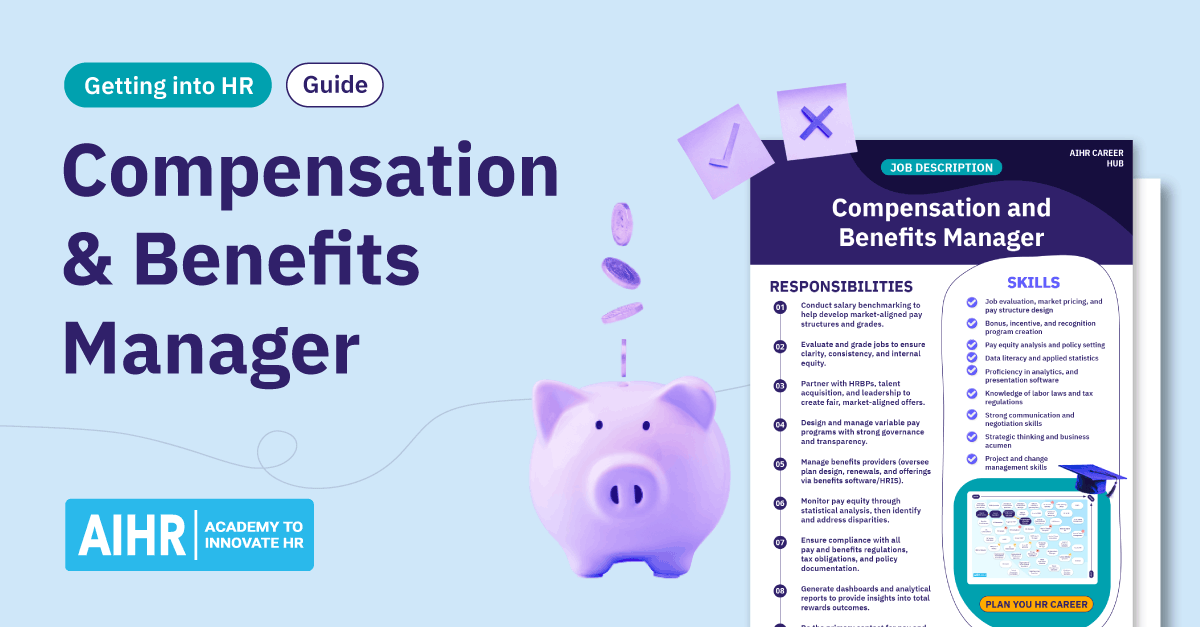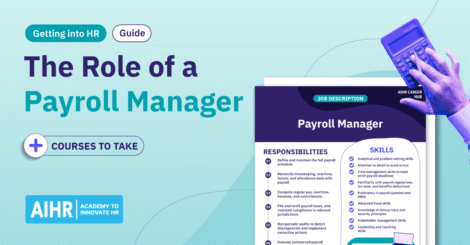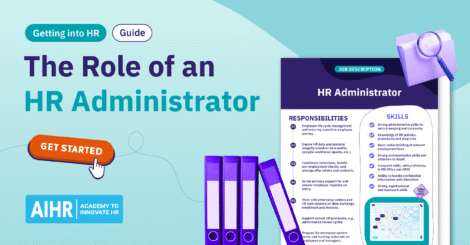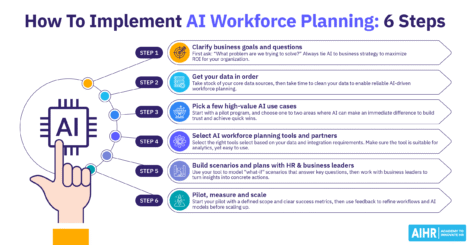Compensation is a major reason employees switch jobs, and a strong lever for retention and performance. Fair, transparent rewards also build trust, accountability, and engagement. That’s why the Compensation and Benefits Manager role is strategic — it sits where people and performance meet.
This article explains what the role entails, the qualifications and skills you need, how much you can earn, and how a C&B career can progress.
Contents
What is a Compensation and Benefits Manager?
Compensation and Benefits Manager job description
Roles and responsibilities of a Compensation and Benefits Manager
Qualifications for a Compensation and Benefits Manager role
Skills and competencies for a Compensation and Benefits Manager role
Average Compensation and Benefits Manager salary
Potential career path for a Compensation and Benefits Manager
AIHR certificate programs to take
Key takeaways
- A Compensation and Benefits Manager designs and governs fair, competitive, and compliant total rewards that align with business goals.
- Core responsibilities include job architecture, pay structure design, market benchmarking, benefits management, governance, and pay equity.
- Certifications like CCP and CEBS deepen expertise; HR analytics skills help you monitor equity and impact.
- Strong C&B strategies balance financial and nonfinancial rewards to drive performance and retention.
What is a Compensation and Benefits Manager?
A Compensation and Benefits (C&B) Manager shapes how an organization rewards its people. They design and oversee employee benefits strategy, from salaries and bonuses to health plans, pensions, pay equity, and workplace perks. They aim to keep rewards fair, competitive, and compliant while supporting business objectives.
C&B Managers work with HR, Finance, Talent Acquisition, and leaders to make pay and benefits decisions. They build job architectures and salary bands to maintain internal equity, and design incentive plans connecting performance to business outcomes.
In smaller companies, this can be a part of a broader HR role but in larger organizations, C&B Managers often lead a specialist team or manage external vendors.
Compensation and Benefits Manager job description
A C&B Manager designs and implements total rewards strategy to attract and keep talent. They set market-aligned ranges, ensure equity and compliance, manage vendors, and advise leaders so rewards are fair, data-driven, and tied to business goals.
Roles and responsibilities of a Compensation and Benefits Manager
Here are the roles and responsibilities of a Compensation and Benefits Manager:
- Conduct market salary benchmarking to set ranges, midpoints, and compa‑ratio targets.
- Develop and maintain salary structures, pay grades, and job architecture documentation.
- Evaluate and grade jobs to ensure clarity, consistency, and internal equity.
- Partner with HRBPs, Talent Acquisition, and leadership on offers, promotions, and retention packages.
- Design and govern variable pay programs (sales, production, company bonuses) with clear rules and transparency.
- Select, negotiate, and manage benefits providers; oversee plan design, renewals, and tailored offerings via benefits platforms/HRIS.
- Monitor pay equity with statistical analysis; address disparities across gender, race, age, and other factors.
- Ensure compliance with pay and benefits regulations, tax rules, and internal policies.
- Produce dashboards and analytical reports for leaders on total rewards trends and risks.
- Serve as the main contact for reward questions; communicate programs clearly to employees and managers.

Qualifications for a Compensation and Benefits Manager role
To succeed as a Compensation and Benefits Manager, you need strategic thinking and technical accuracy. The following qualifications are typically required or preferred for the role:
Educational requirements
Here are the typical educational pathways for becoming a Compensation and Benefits Manager:
- Bachelor’s or master’s degree in HR, business, finance, economics, or a related field
- Solid grounding in finance, statistics, and data analysis for pricing jobs, modeling ranges, and equity reviews.
Recommended certifications
- Certified Compensation Professional (CCP): Offererd by WorldatWork, this certification focuses on compensation design, strategy, and market benchmarking.
- Certified Employee Benefits Specialist (CEBS): This program, developed by the International Foundation of Employee Benefit Plans (IFEBP) and UPenn’s Wharton School, demonstrates expertise in compliance, and different types of employee benefits.
- Compensation Management Specialist (CMS): Also offered by the IFEBP, this program overs core compensation systems, analytics, and governance principles.
- SHRM-CP/SHRM-SCP or HRCI’s PHR/SPHR: These broader HR certifications can also be valuable complements to your HR upskilling efforts.
Work experience
For this role, employers often seek several years in HR in general, or C&B in particular. You might need:
- Experience with data‑driven compensation analysis, employee benefits administration, or governance
- Deeper experience and vendor/leadership exposure for large or global firms.
Build the skills you need to be an efficient C&B Manager
To be an efficient Compensation and Benefits Manager, you must build market-aligned pay structures, ensure equity and compliance, and partner with leaders to tie rewards to business outcomes.
✅ Understand the process of shaping a Total Rewards Strategy
✅ Dive into the job evaluation and grading process, and study various aspects of pay
✅ Interpret data to identify pay gaps and draft an action plan towards pay equity
✅ Learn about compensation benchmarking and using it in compensation management
🎓 Learn at your own pace with the online Compensation & Benefits Certificate Program.
Skills and competencies for a Compensation and Benefits Manager role
Let’s examine the specific skills and competencies expected of a C&B Manager.
Role-specific skills
- Job evaluation, market pricing, and pay structure design (bands, grades, midpoints, compa‑ratios)
- Salary surveys and benchmarking across industries/regions
- Design and governance of bonus, incentive, and employee recognition programs tied to outcomes
- Benefits plan management, renewals, and vendor relationships
- Pay equity analysis and policy setting with data‑driven corrective actions
- Total rewards frameworks and policy development
- Advice on offers, promotions, and salary adjustments
- Clear total‑rewards communication for employees and managers
- Support for M&A or restructures through harmonization.
Technical skills
- Data literacy and applied statistics for modeling, forecasting, and equity analysis
- HRIS, benefits platforms, and compensation tools for accurate data management
- Advanced spreadsheets/analytics and presentation tools for modeling and reporting
- Experience with market data platforms (e.g., Mercer, WTW, PayScale)
- Dashboarding and visualization for executive decision‑making
- Knowledge of labor laws, tax regulations, and compliance reporting
- Budgeting, cost modeling, and financial planning for total rewards.
Soft skills
- Clear communication and relationship‑building with HR, Finance, leadership, and employees
- Negotiation and influence to align stakeholders on rewards strategy
- Governance mindset, integrity, and attention to detail
- Business acumen to connect rewards to company goals
- HR project management to run comp cycles and benefits renewals on time
- Change management skills to implement new pay structures or programs
- Problem‑solving, adaptability, and empathy when handling employee questions
- Continuous learning to keep up with market and regulatory changes.
Average Compensation and Benefits Manager salary
Salary.com reports an average annual salary of $139,888 for a C&B Manager, with typical earnings ranging from $107,996 to $168,977. According to PayScale, this figure is $103,194 per year, and Indeed lists the average C&B Manager base salary as $88,106.
Overall, compensation for this role varies by experience level, organization size, industry, and geographic location. Managers working for multinational firms or overseeing global reward strategies typically draw salaries in the upper end of the range.
Potential career path for a Compensation and Benefits Manager
There are several routes to C&B management. Many HR professionals start as a Payroll Administrator before becoming a Payroll Specialist, then move into a Comp and Ben Specialist role to gain experience in pay structures, benefits administration, and compensation analysis. They may then become a Payroll Manager and later, a C&B Manager.
Others start as a Benefits Coordinator or Administrator, switch to a Payroll Manager role, then progress to C&B Specialist before taking on the manager remit. Some other HR professionals take on the Compensation Analyst role, go on to become a Senior Compensation Analyst, then C&B Specialist and finally, C&B Manager.
To get started on planning your own HR career path, check out the AIHR HR Career Map — you can use it to learn more about different roles and required skills, and plot your next moves.
AIHR certificate programs to take
AIHR offers online certificate programs to help you build the skills needed to grow into a C&B Manager role.
Compensation & Benefits Certificate Program
The Compensation & Benefits Certificate Program helps you design and manage total rewards. It covers job evaluation, market benchmarking, pay structure design, incentive and benefits programs, and pay equity analysis. You’ll learn to evaluate effectiveness and ensure compliance — ideal for C&B Specialists or other HR pros ready for a strategic rewards role.
HR Manager Certificate Program
The HR Manager Certificate Program teaches you to align C&B with broader HR and business goals. You’ll strengthen your grasp of HR policies and compliance, connect pay programs to talent outcomes, and sharpen decision‑making and communication. It’s suitable for C&B professionals moving into wider HR or management roles.
HR Metrics & Dashboarding Certificate Program
The HR Metrics & Dashboarding Certificate Program teaches you to define HR metrics, build dashboards, and translate compensation data into clear insights. You’ll improve your data literacy and visualization, and learn to use analytics to monitor equity and compliance. This program is a good option for C&B pros who want to elevate data‑driven decision‑making.
Next steps
If you’re ready to build a career that blends strategy, analytics, and people impact, now is the time to start your journey toward becoming a Compensation and Benefits Manager. Begin by identifying the skills you need to strengthen, from job evaluation and pay structure design to HR analytics and stakeholder communication.
Then, take a proactive step to develop them through structured learning and certification. Start by exploring AIHR’s HR certifications and courses, designed to help you upskill and support your professional development.


















